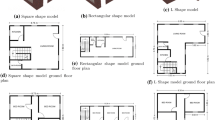Abstract
Existing dynamic energy simulation tools exceed the static dimension of the simplified methods through a better and more accurate prediction of energy use; however, their ability to predict real energy consumption is undermined by a weak representation of human interactions with the control of the indoor environment. The traditional approach to building dynamic simulation considers energy consumption as fully deterministic, taking into account standardized input parameters and using fixed and unrealistic schedules (lighting level, occupancy, ventilation rate, thermostat set-point). In contrast, in everyday practice occupants interact with the building plant system and building envelope in order to achieve desired indoor environmental conditions. In this study, occupant behavior in residential building was modelled accordingly to a probabilistic approach. A new methodology was developed to combine probabilistic user profiles for both window opening and thermostat set-point adjustments into one building energy model implemented in the dynamic simulation tool IDA Ice. The aim of the study was to compare mean values of the probabilistic distribution of the obtained results with a singular heating energy consumption value obtained by means of standard deterministic simulations. Major findings of this research demonstrated the weakness of standardized occupant behavior profile in energy simulation tools and the strengths of energy models based on measurements in fields and probabilistic modelling providing scenarios of occupant behavior in buildings.
Similar content being viewed by others
References
Andersen RV, Olesen BW, Toftum J (2007). Simulation of the effect of occupant behavior on indoor climate and energy consumption. In: Proceedings of Clima 2007: 9th Rehva World Congress: Wellbeing Indoors, Helsinki, Finland.
Andersen RV, Olesen BW, Toftum J (2011). Modelling heating set-point references. In: Proceeding of IBPSA International Conference, Sydney, Australia.
Andersen R (2012). The influence of occupants’ behavior on energy consumption investigated in 290 identical dwellings and in 35 apartments. In: Proceedings of Healthy Buildings 2012, Brisbane, Australia.
Andersen RV, Fabi V, Toftum J, Corgnati SP, Olesen BW (2013). Window opening behavior modelled from measurements in Danish dwellings. Building and Environment, 69: 101–113.
Korjenic A, Bednar T (2011). Impact of lifestyle on energy demand of a single family house. Building Simulation, 4: 89–95.
Baker N, Standeven M (1996). Thermal comfort for free-running buildings. Energy and Buildings, 23: 175–182.
Bakkær Sørensen J (2012). Impact of alternating window opening behavior on different building envelope designs. Master Thesis, Department of Civil Engineering, Danish Technical University, Denmark.
Borgeson S, Brager G (2008). Occupant control of windows: Accounting for human behavior in building simulation. Centre for the Built Environment, Internal Report.
Bourgeois D (2005). Detailed occupancy prediction, occupancy-sensing control and advanced behavioral modeling within whole-building energy simulation. PhD Thesis, Faculté des études Supérieures Université Laval Québec, Canada.
Leaman A, Bordass W (1998). Productivity: The killer variables. Building Services Journal, June: 41–43.
de Dear R, Brager GS (2001). The adaptive model of thermal comfort and energy conservation in the built environment. International Journal of Biometeorol, 45: 100–108.
Clevenger CM, Haymaker J (2006). The impact of the building occupation on energy modeling simulations. Presented at the Joint International Conference on Computing and Decision Making in Civil and Building Engineering, Montreal, Canada.
Wang C, Ya D, Jiang Y (2011). A novel approach for building occupancy simulation. Building Simulation, 4: 149–167.
Emery AF, Kippenhan CJ (2006). A long term study of residential home heating consumption and the effect of occupant behavior on homes in the Pacific Northwest constructed according to improved thermal standards. Energy, 31: 677–693.
Fabi V, Andersen RV, Corgnati SP, Olesen BW (2013). A methodology for modelling energy-related human behavior: Application to window opening behavior in residential buildings. Building Simulation, 6: 415–427.
Fabi V, Andersen RV, Corgnati SP (2012a). Window opening behavior in residential buildings using models based on field survey. In: Proceedings of 7th Windsor Conference: The Changing Context of Comfort in an Unpredictable World, Longon, UK.
Fabi V, Andersen RV, Corgnati SP, Venezia F (2012b). Influence of user behavior on indoor environmental quality and heating energy consumption in Danish dwellings. In: Proceedings of 2nd International Conference on Building Energy and Environment, Boulder, USA.
Haldi F (2013). A probabilistic model to predict building occupants’ diversity towards their interactions with the building envelope. In: Proceedings of IBPSA International Conference, Chambéry, France.
Hoes P, Trcka M, Hensen JML, Hoekstra BB (2011). Optimizing building design using a robustness indicator with respect to user behavior. In: Proceedings of IBPSA International Conference, Sydney, Australia.
Marchio D, Rabl A (1991). Energy-efficient gas heated housing in France: Predicted and observed performance. Energy and Buildings, 17: 131–139.
Nicol JF (2001). Characterising occupant behavior in buildings: Towards a stochastic model of occupant use of windows, lights, blinds, heaters and fans. In: Proceedings of 7th IBPSA International Conference, Rio de Janeiro, Brazil.
Paciuk M (1989). The role of personal control of the environment in thermal comfort and satisfaction at the workplace. PhD Thesis, University of Wisconsin, USA.
Page J, Robinson D, Morel N, Scartezzini JL (2008). A generalized stochastic model for the simulation of occupant presence. Energy and Buildings, 40: 83–98.
Rijal HB, Tuohy P, Humphreys MA, Nicol JF (2007). Using results from field surveys to predict the effect of open windows on thermal comfort and energy use in buildings. Energy and Buildings, 39: 823–836.
Schweiker M, Haldi F, Shukuya M, Robinson D (2011). Verification of stochastic models of windows opening behavior for residential buildings. Journal of Building Performances Simulation, 5: 55–74.
Toftum J, Andersen RV, Jensen KL (2009). Occupant performance and building energy consumption with different philosophies of determining acceptable thermal conditions. Building and Environment, 44: 2009–2016.
Wei S, Buswell R, Loveday D (2010). Probabilistic modelling of human adaptive behavior in non-air conditioned buildings. In: Proceedings of 6th Windsor Conference: Adapting to Change: New Thinking on Comfort, London, UK.
Author information
Authors and Affiliations
Corresponding author
Rights and permissions
About this article
Cite this article
D’Oca, S., Fabi, V., Corgnati, S.P. et al. Effect of thermostat and window opening occupant behavior models on energy use in homes. Build. Simul. 7, 683–694 (2014). https://doi.org/10.1007/s12273-014-0191-6
Received:
Revised:
Accepted:
Published:
Issue Date:
DOI: https://doi.org/10.1007/s12273-014-0191-6




